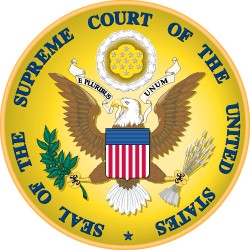SUPREME COURT'S ROLE IN AMERICA
.jpg)
Since its first assembly in 1790, the Supreme Court has
played a vital role in what direction this country has taken.
Through landmark cases like Marbury vs. Madison and Brown vs. The
Board of Education the Court was able to declare final verdicts
that the American government and its citizens would have to abide
by.
The biggest impact of the Supreme Court is the tradition it
upholds. Throughout American history, political parties have
changed, voters' rights have changed, international affairs have
changed, technology keeps expanding, the work force continues to
shift, economies have fluctuated, and yet the Supreme Court
continues to retain its respect, prestige, and power.
.jpg)
Some basic traditions include: The 9 Justices always sitting by
seniority on the bench. The Chief Justice occupies the center
chair and the hierarchical system of seating continues down the
bench. For more than 200 years, Justices are still wearing black
robes while in court. And surprisingly, quill pens have remained
part of the courtroom scene. White quills are placed on the
counsel tables each day, as was done from the inception.
 The Supreme Court also has a traditional seal. The single star
beneath the eagle's claw represents the Constitution's creation of
"one Supreme Court". The seal that is used today is only the fifth
in the Court's history!
The Supreme Court also has a traditional seal. The single star
beneath the eagle's claw represents the Constitution's creation of
"one Supreme Court". The seal that is used today is only the fifth
in the Court's history!
With more than 7,000 cases this term, the Court's workload is
packed. One can only imagine how many cases total have been tried
through the Supreme Court. The following list is just some of the
major cases that have changed the course of history:
- Miranda v. Arizona - Created the Miranda Rights which secures the privilege against self-incrimination
- Roe v. Wade - Affirmed a women's right to an abortion
- Plessy v. Ferguson - Upheld State imposed racial segregation
- Brown v. Board of Education of Topeka - Desegregated public schools
- Gideon v. Wainwright - Guarantees a defendant some representation by a court-appointed attorney
- Engel v. Vitale - Denied prayer reading at public schools
- Marbury v. Madison - Established the Supreme Court's power of judicial review
- Bush v. Gore - No constitutional recount of votes could be made with such time constaints
More information on these cases and many other notable Supreme Court cases can be found at
U.S. Supreme Court Multimedia.
References used for this page:
Official U.S. Supreme Court Site
The Supreme Court Historical Society
This Nation